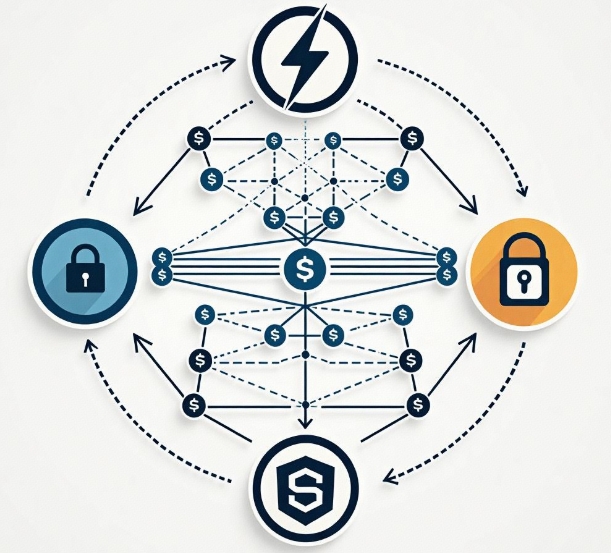How to Optimize Performance and Design Scalability in Blockchain Development
- latest articles
- 1.DApp Development & Customization: Merging Diverse Market Needs with User Experience 2.Analysis of the Core Technical System in DApp Project Development 3.How to achieve cross-chain interoperability in Web3 projects? 4.How does the tokenization of points reconstruct the e-commerce ecosystem? 5.How to Set and Track Data Metrics for a Points Mall? 6.What is DApp Development? Core Concepts and Technical Analysis 7.Inventory of commonly used Web3 development tools and usage tips 8.Development of a Distribution System Integrated with Social E-commerce 9.Six Key Steps for Businesses to Build a Points Mall System 10.What is DApp Development? A Comprehensive Guide from Concept to Implementation
- Popular Articles
- 1.Future Trends and Technology Predictions for APP Development in 2025 2.Analysis of the DeFi Ecosystem: How Developers Can Participate in Decentralized Finance Innovation 3.From Zero to One: How PI Mall Revolutionizes the Traditional E-commerce Model 4.DAPP Development | Best Practices for Professional Customization and Rapid Launch 5.Recommended by the Web3 developer community: the most noteworthy forums and resources 6.From Cloud Computing to Computing Power Leasing: Building a Flexible and Scalable Computing Resource Platform 7.How to Develop a Successful Douyin Mini Program: Technical Architecture and Best Practices 8.Shared Bike System APP: The Convenient Choice in the Era of Smart Travel 9.How to Create a Successful Dating App: From Needs Analysis to User Experience Design 10.From Design to Development: The Complete Process of Bringing an APP Idea to Life
Blockchain technology has become an important component of modern information technology, with its application scenarios continuously expanding from the financial sector to supply chain management, and further to numerous industries such as the Internet of Things. However, as blockchain networks continue to develop, issues of performance and scalability are increasingly emerging. How to enhance the performance of blockchain and give it stronger scalability has become a focus of attention for developers and researchers. This article will delve into how to perform performance optimization and scalability design in blockchain development, introduce common optimization strategies, and analyze the challenges and solutions currently faced by blockchain technology.
I. The Necessity of Blockchain Performance Optimization
Blockchain performance optimization refers to improving the throughput, transaction processing speed, storage efficiency, and other performance aspects of the blockchain network through a series of technical means. The performance issues of blockchain technology directly affect its promotion and adoption in practical applications. Taking Bitcoin as an example, its low transaction processing speed and limited throughput make it difficult to meet the demands of large-scale application scenarios. To enable blockchain to be applied in broader fields, it is essential to address performance bottlenecks and enhance its usability.
II. Directions for Blockchain Performance Optimization
Blockchain performance optimization can primarily be approached from the following aspects:
1. Consensus Mechanism Optimization
The consensus mechanism is the process by which nodes in a blockchain network reach agreement and is one of the key factors affecting performance. Different consensus mechanisms have varying impacts on blockchain throughput, transaction confirmation speed, and energy consumption. Currently, the most common consensus mechanisms are Proof of Work (PoW) and Proof of Stake (PoS).
Proof of Work (PoW): Although PoW is widely used in public chains like Bitcoin, it suffers from long transaction confirmation times and high energy consumption. To address these issues, an increasing number of projects are adopting more efficient consensus mechanisms, such as Proof of Stake (PoS), Delegated Proof of Stake (DPoS), **Byzantine Fault Tolerance (BFT)**, etc. These mechanisms improve transaction confirmation speed and throughput while ensuring security.
Proof of Stake (PoS): Unlike PoW, the PoS mechanism determines block producers based on the "stake" of validating nodes, significantly reducing computational consumption. For example, Ethereum 2.0 replaces PoW with PoS, greatly enhancing network throughput.
2. Block Size and Block Interval Optimization
Blockchain performance is also influenced by block size and block generation interval. Block size determines how many transactions each block can accommodate, while the block interval determines the frequency of new block generation.
Block Size: Increasing block size can enhance throughput but may also prolong block propagation time, potentially affecting the network's degree of decentralization. For instance, Bitcoin's small block size limits its transaction processing capacity, which is why some blockchain projects (like Bitcoin Cash) increase block size to improve performance.
Block Interval: A long block interval leads to slow transaction confirmation, while too short an interval may cause forks and network congestion. Therefore, reasonably adjusting the block interval to ensure timely transaction confirmation is key to optimizing blockchain performance.
3. Off-chain Scaling
Off-chain scaling technology involves moving some transactions or data processing off the main chain to reduce the burden on the blockchain and improve performance. Common off-chain scaling solutions include the Lightning Network, state channels, etc.
Lightning Network: The Lightning Network builds a second-layer payment channel on top of the blockchain, enabling instant transactions and low-cost payments, significantly increasing the transaction throughput of blockchains like Bitcoin.
State Channels: State channels allow users to conduct multiple transactions off-chain, recording only the final state on the blockchain after transactions are completed, thereby reducing the number of on-chain transactions and enhancing the blockchain's processing capacity.
4. Sharding Technology
Sharding is a very important technology in blockchain scalability design. By dividing the entire network into multiple smaller parts (called "shards"), each shard is responsible for processing a portion of transactions or data, enabling parallel processing and improving throughput and scalability.
Taking Ethereum as an example, sharding technology is planned as a key upgrade in Ethereum 2.0. Sharding can effectively enhance Ethereum's transaction processing capability, allowing it to operate on a larger user scale.
III. Challenges in Blockchain Scalability Design
Blockchain scalability design faces many challenges, mainly including the following aspects:
1. Balancing Decentralization and Scalability
One of the core characteristics of blockchain is decentralization, meaning no single entity controls the network. The higher the degree of decentralization, the stronger the network's security and resistance to attacks. However, excessive decentralization may lead to performance bottlenecks, making it difficult to handle a large volume of transactions.
Therefore, when designing for scalability, how to balance decentralization and performance is an important issue. Excessive decentralization may reduce performance, while excessive centralization may compromise network security and transparency.
2. Data Storage and Transmission Bottlenecks
As blockchain networks continue to expand, bottlenecks in data storage and transmission are gradually becoming apparent. Each node needs to store the entire history of the blockchain, and as time goes on, the data volume keeps increasing, posing higher hardware requirements for nodes.
Currently, many blockchain projects employ techniques such as data compression and distributed storage to alleviate the storage pressure on nodes. However, how to solve the storage bottleneck without sacrificing decentralization remains a challenge to be overcome.
3. Network Latency and Bandwidth Limitations
Blockchain scalability is not only related to block generation speed and block size but also to network latency and bandwidth. High network latency slows down block propagation, thereby affecting transaction confirmation speed. To enhance blockchain scalability, it is essential to consider how to optimize network protocols, reduce network latency, and improve bandwidth utilization efficiency.
IV. Future Trends in Blockchain Performance Optimization and Scalability Design
As blockchain technology continues to evolve, performance optimization and scalability design are also advancing. Here are some future trends and development directions:
1. Multi-chain Interconnection and Cross-chain Technology
With the rise of various blockchain projects, cross-chain technology and multi-chain interconnection will become important directions in blockchain scalability design. Through cross-chain technology, different blockchains can achieve the free flow of assets and information, thereby enhancing the interoperability and scalability of the entire blockchain ecosystem.
2. Zero-Knowledge Proofs and Privacy Protection
As blockchain application scenarios expand, privacy protection issues are becoming increasingly important. Zero-Knowledge Proofs (ZKP), as a powerful privacy protection technology, enable transaction verification while ensuring privacy. In the future, ZKP may become one of the key technologies for enhancing blockchain performance and scalability.
3. Integration of Quantum Computing and Blockchain
The development of quantum computing technology may have a significant impact on the security and performance of blockchain. Quantum computing can greatly enhance computational power, thereby providing stronger processing capabilities for blockchain. However, the application of quantum computing may also introduce new security risks. Therefore, how to integrate quantum computing to improve blockchain performance while ensuring its security will become a focus of future blockchain technology research.
V. Summary
Performance optimization and scalability design of blockchain technology are crucial topics in the current blockchain field, directly related to whether blockchain can succeed in large-scale applications. Through optimizing consensus mechanisms, adjusting block size and interval, adopting off-chain scaling technologies, sharding technology, and other means, the performance and scalability of blockchain can be effectively enhanced. However, while improving performance, factors such as decentralization, security, and privacy protection must be considered to ensure that the core advantages of blockchain are not compromised. In the future, with the development of new technologies such as cross-chain technology, zero-knowledge proofs, and quantum computing, the performance and scalability of blockchain will be further improved, promoting its application in various fields.
-

How to achieve cross-chain interoperability in Web3 projects?
With the continuous development of WEB3 technology, Web3 has gradually become an···
-

Inventory of commonly used Web3 development tools and usage tips
With the continuous development of blockchain technology, Web3 has become a hot ···
-

Web3 development trend prediction: analysis of future technology directions and application scenarios
With the gradual development of blockchain technology, the concept of Web3 has m···

 Blockchain
Blockchain












